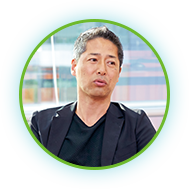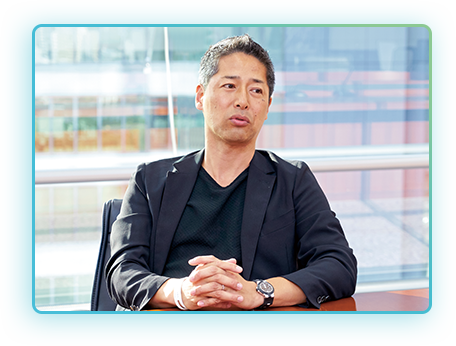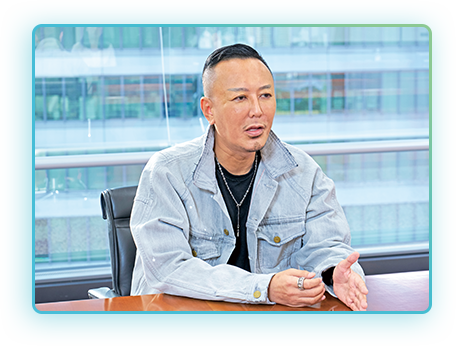Production must not just
be about making the figures match up.
Ayumu Hoshino
You are using an outdated browser.
Please update it to the latest browser.

The heads of development at Sammy and SEGA discuss how the Group is continuing to evolve through the resonance and fusion of the innovative DNA of SEGA and Sammy.

Toshihiro Nagoshi
Director, Chief Product Officer of Entertainment Contents HQ, SEGA Games Co., Ltd.
Director, Chief Product Officer,
SEGA Interactive Co., Ltd.
PROFILE
Joined the former SEGA CORPORATION in 1989; creator of the Ryu ga Gotoku series, which has shipped more than 11 million units worldwide


Ayumu Hoshino
Executive Vice President (Representative Director)
Managing Director of Research & Development Group Division and Development Promotion Division, Sammy Corporation
PROFILE
Joined Sammy Corporation in 1995; directs planning and development of the Pachislot Hokuto No Ken, which holds the No.1 cumulative sales record in the history of pachislot machines, with sales that have surpassed 620,000 units



Nagoshi
When I joined the former SEGA CORPORATION, amusement machines were the center of attraction. Companies that had made an early start were focusing efforts on ambitious initiatives to develop home video game consoles. We struggled to catch up with these companies. And, in the end, we withdrew from hardware. However, since then, one thing that has not changed at all is that SEGA places a great deal of trust in employees. The fundamental task of marketing is to seek overlaps between customer demand and the type of products we want to offer. More than anything, however, SEGA sets store in the passion of its creators. Through its products, the company has delivered creators’ “innovative” ideas to the world without adulteration. Therefore, I think this innovativeness has earned SEGA a unique reputation that sets it apart from peers.
Similarly, our Sales and Marketing Department takes pride in this innovativeness. While this approach has benefits, it also has risks. I think Sammy Corporation also has this dedication to the pursuit of attributes that other companies cannot match.

Hoshino
I agree. Sammy has the same kind of respect for innovativeness. About 20 years ago, the company was really only a third or fourth class manufacturer. Unable to compete with the brand power of major manufacturers, we focused on how we could draw attention to our products. As a result, we came to the conclusion that if we included a host of industry-first functions, people would at the very least take an interest in our products. This was before we even had our current “Sammy… the wellspring of new ideas” slogan. Because we were always looking to incorporate some sort of new functions or gameplay, we often had setbacks. But it is precisely the experience of working with the attitude that it is enough if 30% of new machine models become hit products that has given employees a deeply rooted pioneering mindset. There have been times when I have felt that we were moving forward a little too quickly, but I think SEGA is the same.

Nagoshi
Without question, SEGA has also built its reputation precisely because it has always strode ahead of other companies. For example, we launched the industry’s first RPG with network compatibility, PHANTASY STAR ONLINE, at a time when broadband penetration was almost non-existent. When we realize a daring idea, it certainly causes a great deal of surprise. On the other hand, there is also the risk of a project ending up as pie in the sky. I think that our perseverance in refining these types of ambitious projects has enabled us to create progressive products that overwhelm the offerings of competitors and earn strong long-term endorsement from a large player base.
I also feel that when we push the envelope in our work, benefits invariably emerge afterwards. Ryu ga Gotoku is a product that exemplifies this. At university, I studied movies. I was very puzzled by the fact that people would go to see a movie because it starred a famous actor or actress, but there was no video game that applied an equivalent model. When I began thinking that it would be interesting if an actor starred in a video game in the way that actors star in movies and TV dramas, I was sowing the seeds that grew into the concept for Ryu ga Gotoku. I expected that competitors would roll out titles based on similar concepts. In the end, however, they did not create any enduring products. In the past, competitors mentioned that they had no intention of creating such products because they would not be able to catch up with Ryu ga Gotoku, and these comments made an impression on me. I believe that we have established this position thanks to our creative team and by always adopting a forward-looking stance and continuing to evolve.
The unit sales of Ryu ga Gotoku overseas were only around several 10s of thousand until not that long ago. Recently, however, overseas unit sales have begun to increase as the product’s reputation builds. The appeal of the product, which is the fruit of thoroughgoing efforts in Japan, is spreading over time. Creators have devoted a lot of energy to realizing this appeal, and I think players sense this and take an interest in the video game.
Looking back, I have a real sense of personal growth as a result of working on the project, which allows me to serve as an example for following employee. I think this is the process by which the next generation inherits innovative DNA.

Hoshino
The importance of maintaining a proactive mindset is equally true when it comes to applying for the approval of new-format machines. Due to the February 2018 regulatory revision, manufacturers are submitting products for prototype testing based on new regulations. Normally, manufacturers might initially submit a machine with safer specifications to acquire approval, and then steadily submit machines with more ambitious specifications. On the other hand, unafraid of the possibility of failing to acquire approval, Sammy pursues appealing machines and submits them for testing without compromising on the specifications.
SEGA and Sammy have similar approaches to their industries in the sense that they both value quality over speed in relation to development. At Sammy, our view is that postponing a launch until the next fiscal year is preferable to releasing a sketchy product. The real aim of our efforts to shorten development lead times under Road to 2020 is not to bring machines to market quickly. Instead, our aim is to use the time freed up through shortened development periods to rigorously refine machines.
Product creation must not overemphasize reaching immediate numerical targets and end up just being about making the figures match up. We will not betray the expectations of customers who always want to play the best possible machines. If there is an aspect we stick to figures, I think it is important to bringing forward development lead times a little so that we can conduct repeated product trials on finished machines to refine them and make them as exciting as possible.

Nagoshi
I think we will have acquired the basic strength to respond to changes when we are able to reconcile contradictory aims and say “We will set aside time to increase the quality, but we must not miss the numerical targets.” Previously, there have been times when, despite proceeding as planned, SEGA’s projects have recorded deficits. I think a lack of “change” has been the problem at these time. Because the present management team favors change, instructions change on an almost daily basis. To be honest, frontline operations have undergone many changes as a result. Nonetheless, our figures have become much better. I think that continuing this type of change is needed to win out in today’s volatile times.

Ayumu Hoshino

Toshihiro Nagoshi

Hoshino
I also feel that in order to move forward, continuing to change is essential. At Sammy, as well as focusing on embracing change to create quality products, our awareness of cost in relation to such strategies as reusing and recycling components has increased considerably. The attitude of frontline employees has changed. Previously, we invested capital in products that developers wanted to create. Now, we pursue return on investment by differentiating between areas where we should invest capital and those where we should curb costs. At the same time, we focus on creating products that satisfy players.

Nagoshi
Under Road to 2020, SEGA is actively investing in intellectual properties (IP), including the creation of new IP and the revival of past IP. Revived IP are seeing some success. However, we should not forget that, in addition to long-standing fans, we have to reach current players. Having too much confidence in past successes and simply trying to duplicate them will not generate products that earn acceptance in today’s environment. Setting our sights beyond 2020, I want to take an even more bullish, forward-focused approach to development and increase mainstay product lineup.
With the integration of offices in the summer, this is a year of major changes for the SEGA SAMMY Group. Until now, we have worked with Sammy on various projects. However, we could never synchronize perfectly due to our physical separation. Therefore, I expect that the integration of our offices will activate exchanges of information and accelerate coordination.
For SEGA employees engaged in product development, I think that being able to talk with Sammy’s development personnel will be a great stimulus.

Hoshino
Yes, I think you are right. It will also be very stimulating for Sammy’s employees. Opportunities for communication among personnel will increase as a result of there being less physical distance between them. For example, the new office has a dining area. Therefore, if personnel can share interesting ideas about creating products and come up with new innovations, perhaps over a drink, it could give rise to completely new development projects that would not have occurred to us under the previous system. In the med-to-long term, we want to establish an environment in which increased day-to-day exchanges enhance the mobility of personnel and lead more employees experience the diversity of the Group’s personnel.

Nagoshi
Outside the Group, many people still see SEGA and Sammy as separate entities. I think the task for us going forward is to increase the occasions when we are viewed as a single entity under the “SEGA SAMMY” banner. I hope that the integration of our offices will further strengthen the Group’s brand by enabling us to leverage the innovative DNA that each company has inherited and to align the values that underpin the SEGA SAMMY brand.
IP are a wellspring of value creation. Entertainment companies possessing competitive IP are able to secure stable earnings, which in turn can be utilized to further increase the value of these properties. Accordingly, the competitiveness of entertainment companies hinges on their ability to generate new IP, discern the value of properties licensed from outside, and develop systems for protecting their IP.